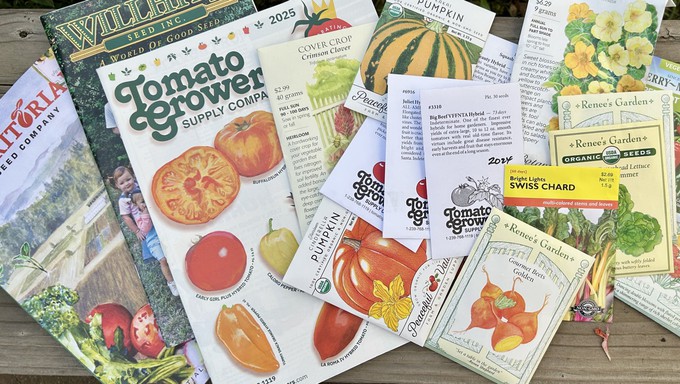
Before buying more, thin your seed stockpile; compost or share the rest

These catalogs are tempting, but it's best to check over the seeds already in hand before ordering more. (Those golden beets? From 2015 -- and headed to the compost pile.) Kathy Morrison
January is both the month of organization and the month when gardeners finally dive into seed catalogs or jump down the rabbit hole of online seed sources. So much fun to choose new varieties to grow!
But first: Declutter that seed collection so everything is up to date and viable. Those onion seeds from 2021 likely should be tossed (in the green waste or compost), since onion seeds last only a year or so. Tomatoes, on the other hand, can do well up to five years, maybe more, so there's no point in buying another packet of a favorite variety without knowing how many usable seeds are left.
As for those other seeds that went unplanted last year: Is there really room in the garden for a patch of Cinderella pumpkins? How about donating them to a good cause (a school or community garden) or trading them in a community seed swap?
Johnny's Selected Seeds online has excellent charts showing seed viability and storage life estimates. Not just vegetables, they cover flowers and farm/cover crop seeds. (Oh, yeah, can I still use that red clover I bought a few years ago?) The Johnny's website also offers tips on seed saving, storage and how to test seed viability.
Seed viability vs. seed germination rate is an important point when saving seeds. As Johnny's notes, "Both germination rate and seed viability can decline with age of the seed. Viability refers to a seed's ability to produce a vigorous seedling. Seed viability typically declines before germination rates do, so it is possible for old seed to still germinate yet produce weak seedlings."
Also important: Seeds must be stored properly. Keeping them in a hot garage will cause them to deteriorate faster than in a closed box in a cool interior closet.
So, what to do with older seeds of varieties you like and want to grow again?
-- Mix them with new seeds if they're scatterable (zinnias, poppies);
-- Start some old ones alongside some new ones (I do this with Juliet tomatoes);
-- Give the old ones a chance. Debbie once found 6-year-old beet seeds that grew just fine; other older seeds never germinated. But unless this is just a garden experiment, as hers was, have a newer backup.
For more information on seeds, seed packets and seed saving, see the UC Sacramento County Master Gardener Garden Note 128, "Understanding Information on a Seed Packet." Search for GN 128 on this page of Master Gardener Publications .
Watch for seed swaps in the region late in the month. National Seed Swap Day is Jan. 25; here's information on the event in Loomis. The Placer master gardeners also will present a workshop on seed saving Jan. 11 during their monthly open garden.
Comments
0 comments have been posted.Sacramento Digs Gardening to your inbox.
Food in My Back Yard Series
April 22: Should you stock up on fertilizer? (Yes!)
April 15: Grow culinary herbs in containers
April 8: When to plant summer vegetables
April 1: Don't be fooled by these garden myths
March 25: Fertilizer tips: How to 'feed' your vegetables for healthy growth
March 18: Time to give vegetable seedlings some more space
March 11: Ways to win the fight against weeds
March 4: Potatoes from the garden
Feb. 25: Plant a fruit tree now -- for later
Feb. 18: How to squeeze more food into less space
Feb. 11: When to plant? Consider staggering your transplants
Feb. 4: Starting in seed starting
Sites We Like
Garden Checklist for week of April 27
Once the clouds clear, get to work. Spring growth is in high gear.
* Set out tomato, pepper and eggplant transplants.
* From seed, plant beans, beets, cantaloupes, carrots, corn, cucumbers, melons, pumpkins, radishes and squash. Plant onion sets.
* In the flower garden, plant seeds for asters, cosmos, celosia, marigolds, salvia, sunflowers and zinnias. Transplant petunias, zinnias, geraniums and other summer bloomers.
* Plant perennials and dahlia tubers for summer bloom. Late April is about the last chance to plant summer bulbs, such as gladiolus and tuberous begonias.
* Transplant lettuce and cabbage seedlings.
* Weed, weed, weed! Don’t let unwanted plants go to seed.
* April is the last chance to plant citrus trees such as dwarf orange, lemon and kumquat. These trees also look good in landscaping and provide fresh fruit in winter.
* Feed citrus trees with a low dose of balanced fertilizer (such as 10-10-10) during bloom to help set fruit. Keep an eye out for ants.
* Apply slow-release fertilizer to the lawn.
* Thoroughly clean debris from the bottom of outdoor ponds or fountains.
* Start thinning fruit that's formed on apple and stone fruit trees -- you'll get larger fruit at harvest (and avoid limb breakage) if some is thinned now. The UC recommendation is to thin fruit when it is about 3/4 of an inch in diameter. Peaches and nectarines should be thinned to about 6 inches apart; smaller fruit such as plums and pluots can be about 4 inches apart. Apricots can be left at 3 inches apart. Apples and pears should be thinned to one fruit per cluster of flowers, 6 to 8 inches apart.
* Azaleas and camellias looking a little yellow? If leaves are turning yellow between the veins, give them a boost with chelated iron.
* Trim dead flowers but not leaves from spring-flowering bulbs such as daffodils and tulips. Those leaves gather energy to create next year's flowers. Also, give the bulbs a fertilizer boost after bloom.
* Pinch chrysanthemums back to 12 inches for fall flowers. Cut old stems to the ground.
* Mulch around plants to conserve moisture and control weeds.